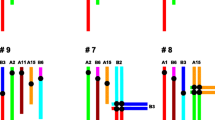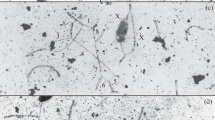Abstract
In male mealy bugs the chromosomes of paternal origin become heterochromatic (H) early in embryogeny while those of maternal origin remain euchromatic (E). First instarPseudococcus obscurus Essig males which were irradiated with 3000 r of X-rays carried translocations between E and H chromosomes [T(E;H)'s] in their spermatocytes. In the T(E;H)'s the border between the E and H segments was usually quite sharp, but occasionally short E segments may have become either partially or completely heterochromatic. During the second meiotic division the E and H sets normally segregate to opposite poles. The T(E;H)'s often formed bridges in AII and TII, but in most of the cells they did succeed in reaching one of the poles. The segregation of the T(E;H)'s depended on the relative size of their E and H segments. When the E and H segments were of the same size, the T(E;H)'s segregated more often with the E chromosomes, even though the latter have been observed to be attached to their pole with fewer spindle fibers. Thirty-five of the 173 males analyzed had sectors in their testes which lacked an H set. The number of cysts per sector suggested that each sector was derived from a single irradiated cell. The karyotypes observed in some of the sectors indicated that the lack of an H set was the result of reversal of heterochromatization and not due to the loss of the H set and the endoduplication of the E set. Most of the cells lacking an H set divided normally during the first meiotic division. The second division, however, was abortive and resulted in the production of diploid sperm. Two possibilities for the origin of spermatocytes lacking an H set are considered: (i) that these spermatocytes resulted from X-ray induced reversal of heterochromatization in spermatogonia, and (ii) that these spermatocytes originated from presumptive cyst wall cells whose H set had undergone reversal prior to the irradiation.
Similar content being viewed by others
References
Berlowitz, L.: Correlation of genetic activity, heterochromatization, and RNA metabolism. Proc. nat. Acad. Sci. (Wash.)53, 68–73 (1965).
Bregman, A. A.: The development of the serosa in male embryos of the mealy bug,Pseudococcus obscurus Essig. J. exp. Zool.169, 173–195 (1968).
Brown, S. W., Nelson-Rees, W. A.: Radiation analysis of the lecanoid genetic system. Genectics46, 983–1007 (1961).
—, Nur, U.: Heterochromatic chromosomes in the coccids. Science145, 130–136 (1964).
Chandra, H. S.: Cytogenetic studies following high dosage paternal irradiation in the mealy bug,Planococcus citri. II. Cytology of X1 females and the problem of lecanoid sex determination. Chromosoma (Berl.)14, 330–346 (1963).
Gerstel, D. U., Burns, J. A.: Penotypic and chromosomal abnormalities associated with the introduction of heterochromatm fromNicotiana otophora intoN. tabacum. Genetics56, 483–502 (1967).
Hughes-Schrader, S.: The chromosome cycle ofPhenacoccus (Coccidae). Biol. Bull.69, 462–468 (1935).
Nelson-Rees, W. A.: New observations on lecanoid spermatogenesis in the mealy bug,Planococcus citri. Chromosoma (Berl.)14, 1–17 (1963).
Nur, U.: Sperms, sperm bundles, and fertilization in a mealy bug,Pseudococcus obscurus Essig. (Homoptera: Coccoidea). J. Morph.111, 173–199 (1962).
—: Reversal of heterochromatization and the activity of the paternal chromosome set in the male mealy bug. Genetics56, 375–389 (1967a).
—: Chromosome systems in theEriococcidae (Coccoidea: Homoptera). II.Gossyparia spuria andEriococcus araucariae. Chromosoma (Berl.)22, 151–163 (1967b).
Russel, L. B.: Mammalia X-chromosome action: Inactivation limited in spread and in region of origin. Science140, 976–978 (1963).
Schrader, F.: The chromosomes ofPseudococcus nipae. Biol. Bull.40, 259–270 (1921).
—: A study of the chromosomes in three species ofPseudococcus. Arch. Zellforsch.17, 45–62 (1923).
Schultz, J.: Genes, differentiation, and animal development. Brookhaven Symp. Biol.18, 116–147 (1965).
Węglarska, B.: Development of testes and spermatogenesis inQuadraspidiotus ostreaeformis (Curt.) (Homoptera, Coccoidea, Aspidiotini). Zeszyty Nauk, UJ, S. Zool.12, 59–98 (1966).
—: Spermatogenesis inQuadraspidiotus ostreaeformis (Curt.) (Homoptera, Coccoidea, Aspidiotini). Zeszyty Nauk, UJ, S. Zool.14, 63–82 (1968).
Author information
Authors and Affiliations
Additional information
Supported by grant GB 6745 from the National Science Foundation, Washington, D. C.
Rights and permissions
About this article
Cite this article
Nur, U. Translocations between Eu- and heterochromatic chromosomes, and spermatocytes lacking a heterochromatic set in male mealy bugs. Chromosoma 29, 42–61 (1970). https://doi.org/10.1007/BF01183660
Received:
Accepted:
Issue Date:
DOI: https://doi.org/10.1007/BF01183660




